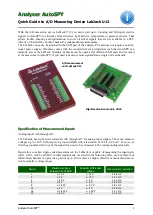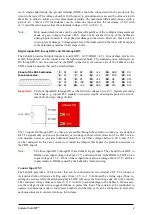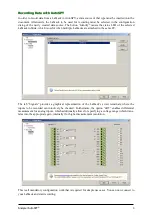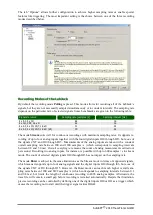
AutoSPY © 2019 TraceTronic GmbH
The tab “Options” allows further configuration to achieve higher sampling rates or enable special
features like triggering. The most important setting is the choice between one of the three recording
modes described below.
Recording Modes of the LabJack
By default the recording mode
Polling
is preset. This mode allows for recording all of the LabJack’s
signals, but they are not necessarily sampled simultaneously or in constant intervals. The sampling rate
depends on the particular mix of selected signals. Some benchmarks are given in the following table:
Signals to record
Sampling rate [samples / s]
Sampling interval [ms]
4 x AI, 4 x IO
62
16
4 x IO, CNT, 16 x D
62
16
4 x AI, 4 x IO, CNT, 16 x D
31
32
8 x AI, 4 x IO, CNT, 16 x D (all)
19
52
The mode
Stream
suits well for continuous recordings with maximum sampling rates. It supports re-
cording of up to four analog inputs together with the four digital inputs IO0 through IO3, but
none
of
the signals CNT and D0 through D15. Measurements of the analog inputs are taken with a constant
overall sampling rate between 200 and 1200 samples / s (which corresponds to sampling intervals
between 0.8 and 5.0 ms).
Overall sampling rate
means the count of analog measurements carried out
per second. Recording two analog inputs, for instance, is possible with up to 600 samples / s in stream
mode. The count of selected digital signals IO0 through IO3 has no impact on the sampling rate.
The mode
Burst
is subject to the same limitations as the Stream mode in terms of supported signals,
which means it supports up to four analog signals and the digital inputs IO0 through I03, but
none
of
the signals CNT or D0 through D15. However, the Burst mode can reach much higher overall sam-
pling rates between 1200 and 8192 samples / s (which corresponds to sampling intervals between 0.1
and 0.8 ms), but limits the length of continuous recording to 4096 analog samples. Afterwards, the
trace file will contain a small gap before recording is restarted automatically. Despite that limitation,
precise recording can be controlled by defining one of the digital inputs IO0 or IO1 as a trigger, which
causes the recording not to start until the trigger signal carries HIGH.






















